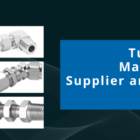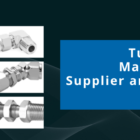Prevent Leakage and Maintain Efficiency with Flushing Rings
Flushing rings, also known as drip rings, diaphragm seals, or bleed rings, are essential components in various industrial processes. They play a crucial role in preventing leakage, maintaining system integrity, and ensuring smooth operation.
Mcneil Instruments is a well-established manufacturer, supplier, and exporter of a variety of high-quality industrial components, including Flushing Rings. With expertise across a wide range of materials such as Monel, Inconel, Stainless Steel, and Hastelloy, Mcneil Instruments delivers reliable products used across major industries like oil & gas, chemical processing, pharmaceuticals, and power generation. The company’s dedication to innovation and quality ensures that their products meet the stringent requirements of modern industrial operations. Among the many products they offer, Flushing Rings stand out for their critical role in maintaining equipment performance and reliability.
What is a Flushing Ring?
A Flushing Ring, also known as a Drip Ring, Diaphragm Seal, or Bleed Ring, is a vital component used in pipeline systems and industrial applications to maintain cleanliness and prevent clogging. It is installed between flanges and pressure measurement instruments, providing a way to clean out any accumulated debris or process fluids without dismantling the system.
These rings are especially important in industries where viscous, corrosive, or hazardous materials are handled, as they allow for periodic cleaning or flushing to ensure smooth operations and accurate pressure readings.
Types of Flushing Rings
At Mcneil Instruments, we offer a variety of Flushing Rings designed to meet specific industrial needs:
- Circular Flushing Rings: Best suited for pipelines, where continuous movement and flexibility are required.
- Square Flushing Rings: Ideal for industrial equipment that experiences heavy loads or vibrations.
- Rectangular Flushing Rings: Used for systems requiring a larger surface area of protection and where structural integrity is crucial.
- Monel Flushing Rings: Known for their excellent corrosion resistance and high-temperature capabilities.
- Nickel Flushing Rings: Offer good corrosion resistance and are suitable for various industrial processes.
- Inconel Flushing Rings: Provide exceptional heat resistance and corrosion resistance, making them ideal for high-temperature applications.
- Incoloy Flushing Rings: Known for their strength and resistance to oxidation and carburization.
- Hastelloy Flushing Rings: Offer excellent corrosion resistance in harsh environments, including those involving acids, alkalis, and salts.
- Titanium Flushing Rings: Lightweight and corrosion-resistant, making them suitable for aerospace and marine applications.
- Stainless Steel Flushing Rings: Provide a good balance of strength, corrosion resistance, and cost-effectiveness.
- Carbon Steel Flushing Rings: Economical and suitable for general-purpose applications.
- Duplex Steel Flushing Rings: Offer excellent corrosion resistance and mechanical properties.
- Alloy Steel Flushing Rings: Provide high strength and durability for demanding applications.
How Do Flushing Rings Work?
Flushing rings are typically installed between two flanges or valves. They create a seal that prevents leakage of fluids or gases, ensuring system integrity and preventing contamination.
Flushing Rings are designed with one or more ports that allow for the introduction of cleaning fluid into the pipeline system. The fluid flows through the ring, cleaning the diaphragm seals or other connected components. This prevents the buildup of materials such as sediment or sludge, which can compromise system performance or lead to inaccurate pressure readings.
The ring is placed between flanges, ensuring there is no disruption to the flow of material through the pipeline during the flushing process.
Advantages of Using Flushing Rings
Flushing Rings offer a wide array of benefits, making them indispensable for many industries:
- Prevents Blockages: Helps clear out sediment and other debris to avoid blockages.
- Enhances Safety: Particularly useful in handling hazardous materials by preventing the accumulation of dangerous substances.
- Improves Accuracy: Ensures the accurate measurement of pressure in industrial systems.
- Easy Maintenance: Allows for cleaning without disassembling pipelines or equipment, reducing downtime.
Material of Construction for Flushing Rings
Mcneil Instruments manufactures Flushing Rings from a wide variety of materials to ensure durability, corrosion resistance, and suitability for different industrial conditions:
1. Monel Flushing Rings
- Grade: Monel 400, Monel K500, Monel R-405
- Corrosion-resistant, ideal for marine and chemical environments.
- Excellent strength in high-temperature applications.
2. Nickel Flushing Rings
- Grade: Nickel 200, Nickel 201
- High resistance to corrosion and oxidation.
- Suitable for extreme temperature variations.
3. Inconel Flushing Rings
- Grade: Inconel 600, 601, 625, 718
- Offers excellent strength and oxidation resistance at high temperatures.
- Ideal for heat-treating and chemical industries.
4. Incoloy Flushing Rings
- Grade: Incoloy 800, 800H, 800HT
- Known for superior mechanical properties in high-temperature environments.
- Commonly used in petrochemical and nuclear industries.
5. Hastelloy Flushing Rings
- Grade: Hastelloy B2, B3, C22, C276, X
- Outstanding corrosion resistance in severe environments.
- Used in chemical processing and pollution control equipment.
6. Titanium Flushing Rings
- Grade: Gr1, Gr2, Gr3, Gr5, Gr7, Gr11
- Lightweight and strong, with excellent corrosion resistance.
- Ideal for aerospace and marine applications.
7. Stainless Steel Flushing Rings
- Grade: 304, 304L, 316, 316L, 321, 347, and more
- Corrosion-resistant and durable, perfect for varied industrial uses.
- Commonly used in food processing and pharmaceutical industries.
8. Carbon Steel Flushing Rings
- Grade: ASTM A 234 WPB, WPBW, WPHY
- Durable and cost-effective for high-pressure applications.
- Ideal for general industrial use.
9. Duplex Steel Flushing Rings
- Grade: ASTM / ASME A/SA 182 UNS F44, F45, F51, F53, F55, F60, F61
- Combines high strength with excellent corrosion resistance.
- Perfect for offshore and chemical processing industries.
10. Alloy Steel Flushing Rings
- Grade: ASTM SA 182, AISI4130, AISI4340, F22, F91
- Known for high toughness and resistance to wear.
- Suitable for high-temperature, high-pressure applications.
Applications of Flushing Rings
Flushing Rings are versatile components used in various industrial settings:
- Chemical Plants: For cleaning diaphragm seals in pipelines carrying reactive chemicals.
- Oil & Gas: Helps maintain accurate pressure readings in pipelines carrying crude oil and natural gas.
- Pharmaceutical: Ensures clean and sterile conditions by preventing the buildup of process fluids.
- Power Generation: Used in steam pipelines and other high-pressure systems to remove debris and ensure smooth operations.
Why Choose Mcneil Instruments for Your Flushing Rings?
At Mcneil Instruments, we take pride in offering high-quality Flushing Rings that meet the specific needs of various industries. Our expertise in material selection, combined with cutting-edge manufacturing processes, ensures our products are reliable, durable, and effective in even the most demanding environments.
- High-Quality Materials: We use premium materials that meet international standards.
- Custom Solutions: We offer customized flushing rings to meet specific industrial requirements.
- Durability: Our products are designed to withstand harsh industrial environments.
- Global Reach: We are trusted suppliers to industries worldwide, ensuring timely delivery and excellent service.
Conclusion
Flushing Rings are an essential part of any system requiring precise pressure measurements and frequent maintenance. At Mcneil Instruments, we provide a wide range of Flushing Rings designed to meet the needs of various industries, ensuring that your operations remain smooth, efficient, and safe. With our dedication to quality and innovation, Mcneil Instruments remains a trusted partner for industrial solutions worldwide. Reach out to us today to learn more about how our Flushing Rings can enhance your industrial processes.









